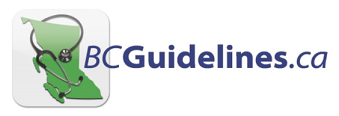BC Guidelines
BC Guidelines are clinical practice guidelines and protocols that provide recommendations to B.C. practitioners on delivering high quality, appropriate care to patients with specific clinical conditions or diseases. These “Made in BC” clinical practice guidelines are developed by the Guidelines and Protocol Advisory Committee (GPAC), an advisory committee to the Medical Services Commission. The primary audience for BC Guidelines is BC physicians, nurse practitioners, and medical students. However, other audiences such as health educators, health authorities, allied health organizations, pharmacists, and nurses may also find them to be a useful resource.
There are several ways to find the guidelines you are looking for.
- Browse the guidelines alphabetically or by topic area.
- You can also download the entire collection of BC Guidelines (ZIP, 68.2MB) for future reference.
What's New
For information on COVID-19, visit the BC Centre for Disease Control website.
REVISED: Chronic Kidney Disease – Diagnosis and Management
The Chronic Kidney Disease – Diagnosis and Management guideline provides recommendations for the investigation, evaluation, and management of adults at risk of/or with known chronic kidney disease (CKD).
Key Recommendations
- Screen high-risk patients (e.g., diabetes, hypertension, cardiovascular disease, family history, and those with a history of acute kidney injury) using estimated Glomerular Filtration Rate (eGFR) and urine Albumin-Creatinine Ratio (ACR). Confirm abnormal test results with a repeat measurement and obtain urinalysis (microscopic).
- Determine likely cause of kidney disease where possible. This has important implications for determining risk of End Stage Kidney Disease (ESKD)/Kidney Failure and other complications.
- Use disease modifying drugs to control hypertension and proteinuria that prevent or postpone kidney function decline.
- All patients with CKD: Initiate an ACE inhibitor (ACE-I) or angiotensin receptor blocker (ARB).
- [NEW] Patients with CKD and uACR ≥20 mg/mmol: In addition to ACE-I/ARB, start a sodium-glucose cotransporter 2 inhibitor (SGLT2i), unless contraindicated.
- [NEW] Patients with CKD and heart failure: In addition to ACE-I/ARB, start a SGLT2i, unless contraindicated.
- [NEW] Patients with CKD and type 2 diabetes: In addition to ACE-I/ARB and SGLT2i, include a non-steroidal mineralocorticoid receptor antagonist (ns-MRA) and a glucagon-like peptide-1 receptor agonist (GLP-1 RA) to optimize renal and cardiovascular outcomes.
- Prescribe statins for CKD patients ≥ 50 yrs and for those 18-49 yrs with cardiovascular risk factors.
- Hold ACE-I, ARB, SGLT2i, and diuretics if patient has acute illness with dehydration, with a plan to restart.
- To assist in determining the need for and timing of referral, obtain advice from local internists, nephrologists or RACE.
REVISED: Cervical Cancer Prevention and Screening
Revisions to the Cervical Cancer Prevention and Screening Guideline to reflect changes in the BC Cancer screening program as well as HPV9 vaccine dose schedule recommendations and Immunize BC program eligibility.
REVISED: Chronic Obstructive Pulmonary Disease
Minor revisions to the Chronic Obstructive Pulmonary Disease (COPD) guideline to reflect new PharmaCare regular benefit coverage for Tiotropium.
NEW: Tobacco Use Disorder (TUD)
The Tobacco Use Disorder (TUD) guideline provides evidence-based recommendations for primary care practitioners on managing tobacco use disorder (TUD). This guideline also addresses vaping. While the guideline focuses on TUD in adults (ages ≥ 19), there are some recommendations addressing the youth population (ages 12-18).
Key Recommendations
- Tobacco use disorder (TUD) (defined in the DSM-5-TR), like other substance use disorders, is a chronic and often relapsing condition. Document smoking history by number of years spent smoking (now considered a better risk indicator than “pack years”). Ask regularly about smoking status and document tobacco use in the patient medical record, including number of cessation attempts.
- Acknowledge that relapse is common and can be expected. If a patient has resumed tobacco use, offer education and review and adjust their smoking cessation plan.
- Continue to provide brief interventions (BI), which are effective when routinely repeated. Consider a motivational interviewing (MI) approach with all patients, including those not yet ready to stop smoking.
- The most effective way to stop smoking is a combination of both pharmacotherapy and counselling. Treatment plans should be individually and collaboratively tailored.
- Medications: Encourage first-line pharmacotherapy, including nicotine replacement therapy (NRT), varenicline, and bupropion.
- Counselling: Smoking cessation programs provide support to those who plan to quit smoking. Encourage patients to connect with QuitNow or to the FNHA’s Talk Tobacco Program.
- Ask regularly about and document vaping use (including youth). Advise and support efforts to quit vaping.

